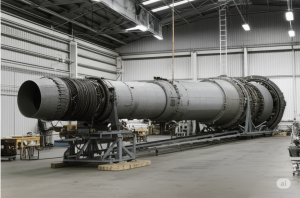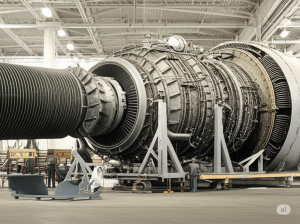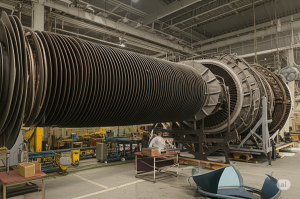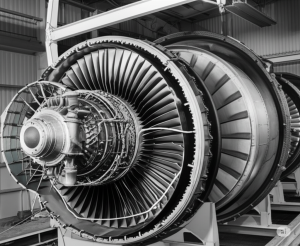The annals of aviation history are filled with tales of groundbreaking engines that pushed the boundaries of what was thought possible. Among these titans, the General Electric GE4 turbojet stands as a particularly impressive, albeit ultimately unrealized, achievement. Stretching nearly 30 feet and capable of generating a staggering 63,000 pounds of thrust with its afterburner, the GE4 was truly the king of its era – a powerhouse designed to usher in an age of supersonic commercial travel that, for it, never fully materialized.

Imagine the sheer scale of this engineering marvel. As the provided image underscores, the GE4 was not a mere component; it was a behemoth. To put its size into perspective, it was longer than many small airplanes of its time. This imposing stature was necessary to house the advanced compressor, combustor, and turbine sections required to deliver its record-breaking thrust.
The numbers themselves are astonishing. At its peak performance with the afterburner engaged, the GE4 could unleash 63,000 pounds of force. To truly grasp this, consider that this output was triple the thrust produced by each of the twin J79 engines that powered the iconic McDonnell Douglas F-4 Phantom II fighter jet, a symbol of American air power during the Cold War. It was also double the thrust of each of the Pratt & Whitney J58 engines that propelled the legendary Lockheed SR-71 Blackbird, the Mach 3+ spy plane that captivated the world. The GE4 was in a performance league of its own.

The ambition behind the GE4 was as grand as the engine itself. It was specifically designed to be the powerhouse for the Boeing 2707, America’s contender in the race to build a commercially viable supersonic transport. In the 1960s, the world was captivated by the idea of crossing continents at speeds faster than the speed of sound. The Anglo-French Concorde project was well underway, and the United States aimed to leapfrog its European counterparts with a larger, faster, and more advanced SST.
The Boeing 2707 was an audacious design, initially envisioned with a swing-wing configuration similar to the General Dynamics F-111. This sophisticated feature was intended to allow for efficient low-speed flight during takeoff and landing, while the swept-back configuration would enable high-speed supersonic cruise. Powering this ambitious aircraft would require an engine of unprecedented capability, and General Electric rose to the challenge with the GE4.

Tragically, the dream of the American SST, and with it the widespread application of the GE4 engine, was never fully realized. By the early 1970s, the Boeing 2707 program faced mounting headwinds. Concerns about the environmental impact of supersonic flight, including noise pollution and potential damage to the ozone layer, grew significantly. Economic challenges, including development costs that ballooned far beyond initial estimates, also played a crucial role. Ultimately, political will for the project waned, and the Boeing 2707 was officially canceled in 1971.
With the cancellation of its intended aircraft, the mighty GE4 engine was also shelved. Despite the immense technological achievement it represented, it never had the opportunity to power a commercial airliner into supersonic flight. Only a handful of GE4 prototypes were ever built, making them rare and significant artifacts of aviation history.

While the GE4 never achieved its intended purpose, its legacy endures. It stands as a testament to the ambition and ingenuity of engineers in the quest for faster and more powerful propulsion systems. The knowledge and technologies developed during the GE4 program likely contributed to advancements in other areas of jet engine design.
The story of the GE4 and the Boeing 2707 serves as a fascinating case study in the complex interplay of technological ambition, economic realities, environmental concerns, and political decisions that shape the course of innovation. Though the uncrowned king of thrust never soared in commercial service, its sheer power and the vision it represented continue to captivate those who look back at the golden age of aerospace development. The GE4 remains a monumental reminder of a dream of supersonic travel that, while partially realized by others, ultimately eluded this American giant.


